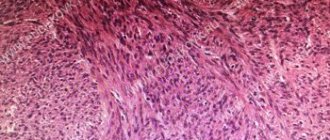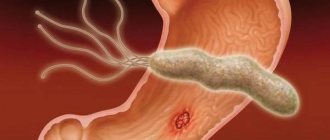- home
- general surgery
- Abdominal adhesions
Interview with Professor Puchkov on the First Medical Channel on the topic: Adhesive disease
As a rule, the internal organs and tissues of the body have a smooth surface. Normally, organs do not stick together and glide easily. When the surface of an organ, tissue, or body cavity is damaged, inflamed, or has a scar, there is a risk of adhesions between organs (adhesions). The organs are connected to each other by fibrous fibers and “stick” to each other. This phenomenon is called adhesive disease.
How does adhesive disease develop?
Mostly this process does not cause concern. In the human body, on the intestines and abdominal organs, connective tissues grow, which block blood flow in the organs and disrupt their functioning.
Depending on the cause of occurrence, adhesions can be single or multiple. Up to a certain point, they do not cause serious discomfort or pain. But with active growth, connective tissue can disrupt the functioning of the gastrointestinal tract and lead to intestinal obstruction.
Often this process continues for several months or years.
Sources
- Abdominal Adhesions What are abdominal adhesions?, NIH - [https://www.niddk.nih.gov/health-information/digestive-diseases/abdominal-adhesions] (https://www.niddk.nih.gov/health- information/digestive-diseases/abdominal-adhesions)
- Abdominal Adhesions, Medicine Central - [https://im.unboundmedicine.com/medicine/view/5-Minute-Clinical-Consult/117470/all/Abdominal_Adhesions] (https://im.unboundmedicine.com/medicine/view/ 5-Minute-Clinical-Consult/117470/all/Abdominal_Adhesions)
- Alisher Zh. Dairbekov, Zhandos T. Tileuberdi, Nurbolat E. Kuanyshbaev. Prediction and prevention of adhesion formation of the abdominal cavity [Electronic resource] // International Student's Journal of Medicine, 2015.
- Korell M. Methoden der Adhäsionsprophylaxe [Electronic resource] // J GYNÄKOL ENDOKRINOL - 2010.
- Boychuk AV, Kurylo OU, Tolokova TI Prevention Of Adhesions In The Preservation Of Reproductive Health [Electronic resource] // Research Journal of Pharmaceutical, Biological and Chemical Sciences, 2022.
- C. Brochhausen, V. H. Schmitt. Intraperitoneale Adhäsionen [Electronic resource] // BIOmaterialien, 2009.
Causes of development of adhesive disease of the abdominal cavity
Adhesions form for several reasons; they often occur as a result of surgery if:
- The manipulations were carried out inappropriately, the surgeon’s work was too rough, his qualifications were low.
- At the time of the intervention, the doctor’s gloves or instruments came into contact with the tissues of the organ, causing certain changes in them.
- The operation was complex; during its implementation, internal organs were affected and damaged.
- The sutures were placed incorrectly, with irregularities, as a result of which the growth of connective tissue began.
In addition to surgical interventions, the disease has other causes:
- inflammatory diseases that developed after surgery or before it;
- infectious diseases of a gynecological nature, in the absence of adequate therapy;
- carrying out radiation therapy in the treatment of oncological diseases.
Often adhesions occur after appendicitis is removed; this simple operation can lead to undesirable consequences.
What causes adhesions to form in the pelvis
Inflammation of the pelvic organs. The disease is diagnosed in women who have suffered acute inflammation or suffer from chronic:
- colpitis;
- endometritis;
- andexite;
- parametritis and other diseases.
Operations. Adhesive disease appears in 16% of those operated for the first time and in 96% of women after the third operation. The percentage is high for laparotomy operations:
- appendectomy;
- C-section;
- removal of appendages;
- hysterectomy;
- supravaginal amputation.
Pelvic hemorrhages. The trigger is ovarian apoplexy, bleeding due to a ruptured tube during an ectopic pregnancy.
Endometriosis. The formation of fibrinous ties is provoked by endometrioid growths, which spread to the organs and peritoneum of the pelvis.
Pelvic injuries. Open and closed damage after accidents, falls from a height received at work are one of the reasons for the appearance of adhesions.
Predisposing factors. The occurrence and development of the disease is influenced by:
- invasive gynecological interventions;
- promiscuous sex life;
- late visit to the clinic.
Adhesive disease with predominant pain syndrome
Spasms, discomfort in the abdominal area, are often a consequence of the formation of adhesions. Discomfort occurs when moving, can limit mobility, and often bothers you after eating.
Depending on the location, adhesions can disrupt blood flow to the organs of the digestive system. The result of this is pain, which often bothers a person.
It can be combined with other symptoms, increasing discomfort.
Pain occurs not only due to impaired blood flow, but also as a consequence of changes in the functioning of the organs of the digestive system. Due to adhesions, they cannot contract normally and the formations interfere.
Is it possible to get pregnant during adhesions?
Adhesions disrupt the proper functionality of the reproductive organs, which greatly reduces the chance of getting pregnant. There is a chance of pregnancy and its successful gestation, especially in cases where the adhesive process affected only one tube. But the likelihood of conception decreases, and the risk of ectopic pregnancy and miscarriage also increases.
In this case, IVF may help. The fallopian tubes are not involved in such fertilization, and a 3-5-day-old embryo is immediately implanted into the uterine cavity.
Adhesive disease with a predominance of dyspeptic disorders
This is when, in addition to pain, other, unpleasant signs appear, which indicate that the adhesive process is actively developing. What worries a person:
- Nausea, vomiting, often occurring after eating, and it can be episodic in nature and appear after eating certain foods.
- Abnormal bowel movements, frequent constipation that are not related to lifestyle or diet.
- Belching that occurs after eating, with possible backflow of stomach contents into the esophagus and oral cavity.
In women, pain can be localized in the area of the organs of the reproductive system, which makes diagnosis difficult. However, other signs are also present.
Pain with intestinal adhesions and other signs
There are several signs that may indicate the development of the pathological process in question:
- periodic vomiting that occurs regardless of food intake;
- pain in the abdomen or chest cavity;
- chronic constipation;
- violation of the passage of gases.
These are characteristic signs of the adhesive process. Pain from intestinal adhesions may not depend on food intake and increases over time. Symptoms of diaphragmatic adhesions are manifested by pain at the border between the chest and abdominal cavities, impaired excursion (movement) of the diaphragm and difficulty breathing. Clinical symptoms of adhesions in the pelvis may be absent.
Adhesive disease lasts a long time: abdominal pain occurs frequently, then becomes constant, its intensity increases.
Diagnostic scheme
There are several methods that can help diagnose the disease. Often patients are not aware that processes are occurring in their body that disrupt the functioning of the gastrointestinal tract.
It is impossible to diagnose the disease using any tests. But there are other ways that will help in diagnosing the disease:
| X-ray examination with the introduction of a contrast agent: | Allows you to obtain the necessary information about the condition of the abdominal organs. |
| Ultrasound: | In some cases, ultrasound examination helps to diagnose changes affecting tissues, but often additional diagnostic procedures are required. |
| CT or MRI of the abdominal cavity: | Depending on the patient’s condition, the examination will be carried out with or without the administration of a contrast agent. |
Laparoscopy may be prescribed as a diagnostic test; it is carried out to determine the extent of damage to organs by the adhesive process, as well as to eliminate adhesions and remove them. Thereby normalizing the function of the gastrointestinal tract.
Laparoscopic and endoscopic examinations are considered optimal because they provide complete information about the condition of the tissues.
How to do it:
Necessary rehabilitation after surgery
Treatment of adhesive disease of the abdominal cavity after surgery is accompanied by a lack of physical activity and proper nutrition. The clinic on Yauza has a hospital and a rehabilitation center. Specialists will help you recover after the intervention and select an individual diet. Patients are constantly monitored during hospital treatment. If necessary, therapy is adjusted to increase effectiveness.
Eating is allowed on the second day after surgery. During the postoperative period, the patient is allowed only liquid meals. The patient is discharged for 3-4 days.
At the Yauza Clinic, the operation takes approximately 60 minutes with minimal damage to healthy tissue. Fast rehabilitation, minimal risk of complications and European-level medical services are what our patients invariably receive.
Sign up for the procedure
Treatment
Conventionally, therapy can be divided into several stages, it includes:
- Carrying out operations aimed at removing adhesions.
- The use of drugs that promote the resorption of connective tissue formations.
- Carrying out physiotherapeutic procedures to help reduce adhesions in size.
- Nutritional corrections are carried out if a person does not have serious bowel dysfunction.
Surgical therapy
Abdominal surgery is rarely performed if a person is concerned about intestinal obstruction. Abdominal surgery does not solve the problem; it can provoke the formation of new adhesions.
But if it is not possible to correct the patient’s condition in any other way, doctors do the following:
- open the abdominal cavity in the area of the affected organ;
- adhesions are excised through surgery using a scalpel;
- restore the functioning of the digestive system and close the patient’s abdominal cavity.
Laparoscopy is considered gentle, as it does not involve opening the abdominal cavity, and therefore reduces the risk of adhesions.
Often, adhesions are cut with a laser beam, which helps eliminate formations and reduce potential risks. But such an operation is considered expensive and is performed on certain patients, if indicated.
Recovery after surgery
Carrying out abdominal surgery involves going through a recovery period. It consists of following certain rules that will help avoid the re-formation of adhesions on the abdominal organs.
The recovery period may take several weeks or months. Depending on the complexity of the surgical intervention performed on the patient.
Prevention of adhesions
For the prevention and treatment of adhesions, enzyme preparations based on hyaluronidase are used. Perhaps the most popular drug for the treatment of adhesions in gynecology is Longidaza suppositories.
Prevention is mostly aimed at preventing relapses of the disease or before an upcoming operation (since adhesions often appear after them).
Remember that the best prevention is regular visits to the doctor and timely diagnosis. Don’t delay until later and sign up for a pelvic ultrasound or a consultation with a gynecologist.
If you feel acute pain in the abdominal cavity or pelvic organs, do not delay visiting a doctor - prevent the development of the disease. Doctors at the Doctor A clinic will conduct an expert examination and prescribe competent treatment. Call or make an appointment online.
Possible complications and prognosis for life
If a person received help in a timely manner, then serious health consequences should not be expected. Therefore, we can say that the prognosis for the disease is favorable.
But to avoid relapse of adhesions, you will have to:
- Regularly undergo diagnostic tests to monitor the condition.
- Follow a diet and avoid certain foods that are potentially hazardous to health.
- Lead a healthy lifestyle, normalize physical activity, avoid drinking alcohol.
A complication of surgery to remove adhesions may be worsening of the pathological sag. For this reason, it is so important to monitor the condition and avoid secondary infection.
general information
All human internal organs easily move relative to each other thanks to the slippery membrane covering them. The mobility of an organ is an important criterion for its good condition and ability to perform its functions. Conversely, any violation of mobility, fixation, attachment to another structure means pathology, which inevitably leads first to malfunctions in the functioning of the organ (functional disorders), and over time to changes in its tissues (structural disorders).
error
The formation of adhesions on the ovaries, tubes (uterine appendages) is a connection (soldering) of the internal organs of the small pelvis that is not provided for by nature, disrupting their normal mobility.
Causes
The most common causes of the formation of adhesions of organs in the pelvis in women are as follows:
- abdominal surgeries,
- surgical abortions,
- long-term “hidden” infections,
- untreated or insufficiently treated inflammation of the uterine appendages,
- appendectomy,
- some venous diseases (gonorrhea, chlamydia),
- consequences of ovarian apoplexy,
- internal endometriosis.
The number of adhesions after delivery by cesarean section is two to three times greater than after laparoscopic operations on the pelvic organs. They can attach not only to the uterus, but also to the ovaries, rectum, and bladder, which leads to the appearance of certain symptoms. More than 50% of cases of abdominal pain and ovario-menstrual cycle disorders in girls are a consequence of the formation of adhesions in the pelvis.
How adhesions form in the pelvic organs
Let's consider the mechanism of formation of adhesions in women - regardless of the cause, it is approximately the same.
The space between the organs in our abdomen is filled with abdominal fluid. It is secreted by the peritoneum - a thin layer lining the abdominal cavity from the inside. With inflammation of internal organs, especially with genital infections, after surgery, the peritoneum becomes irritated, the secretion of fluid increases sharply, while the latter becomes more viscous and sticky (this is how nature helped our ancestors to localize, “seal up” deep damage from the inside).
In addition, when getting to the diseased organ during surgery, the surgeon cuts the multilayer films that ensure the free sliding of the organs. After the operation to remove an ovarian cyst, apoplexy, or appendicitis, sutures remain that tie this entire complex structure into knots, and the sticky liquid continues to be intensely released into the abdominal cavity for some time and begins to “glue” neighboring organs and tissues together.
As a result of the formation of the first point adhesions near the ovary or uterus, the axes of movement of these adherent organs change: they begin to move around the point of connection. Since movement near the commissure is limited, its area increases, increasingly reducing the mobility of the organ. Over time, a dense scar forms at the junction, which “tightly” holds the organs and tissues together.
ICD-10 code N73.6 Pelvic peritoneal adhesions in women.
What do adhesions look like in the pelvis (photo)
Photo 1. Adhesions around the ovary (stage of removal surgery).
Photo 2. Adhesions in the pelvis behind the uterus (chronic adnexitis)
Photo 3. Adhesion and adhesive process in the area of the appendages and uterus.
Due to the restriction of natural mobility, inadequate position and trajectory of movement of the organ, the work of the communications going to it is disrupted, which are stretched, pinched, twisted, etc. In this case, normal blood circulation and lymph flow may be disrupted, and spasms of the supporting ligaments and muscles may occur. To avoid consequences, after gynecological manipulations and operations in the pelvic area, it is necessary to undergo preventive treatment (read more about methods of treating adhesions in gynecology below).
Why is the adhesive process dangerous?
It would seem, what danger is fraught with removing the appendix? However, in this case, intestinal loops, primarily the cecum, are often involved in adhesive processes in the pelvis. Typical consequences are constipation, dysbacteriosis, biliary dyskinesia, etc. Girls often develop adhesions in the appendages, which can subsequently lead to painful periods, infertility, and ectopic pregnancy.
Recently, laparoscopy through a small hole has become popular in gynecology. With it, for a better view, the abdominal cavity is filled with gas. But if before the intervention the organs were perfectly ground in and easily slid relative to each other, then after surgery on the appendages or uterus, when the gas pressure subsides, their relative position differs from the original one. As a result, their mobility also decreases. In addition, during laparoscopy, the peritoneum is still noticeably irritated and secretes a sticky fluid, which leads, as during abdominal surgery, to the formation of adhesions in the pelvic organs, only on a smaller scale.
The most common complications of untreated adhesions on the ovaries in women are:
• infertility, • pain in the lower abdomen and during sexual intercourse, • varicose veins of the uterus and appendages; • backward bending of the uterus, • obstruction of the fallopian tubes, • ectopic pregnancy, • various menstrual cycle disorders.
Doctors often have to deal with the consequences of an episiotomy (an incision in the vagina during childbirth). A small incision to facilitate the passage of the fetus is a common occurrence in obstetric practice. However, over time, scarring of the vaginal tissue can lead to disruption of the position of the internal genital organs, dilated veins and varicose veins, and prolapse of the bladder and uterus. What can we say about possible adhesions in the pelvis after a cesarean section.
Symptoms of adhesions in the pelvis
So, in women, the adhesive process from the ovaries can spread in different directions, ultimately forming long chains of rigidly connected organs, tissues, and ligaments. Further damage occurs according to the principle “where it is thin, it breaks,” that is, the disease affects the most weakened organ located anywhere in such a chain (ovary, fallopian tube, ligaments).
The range of symptoms of adhesions in the appendage area is very wide. For example, restriction of lymph flow in the reproductive organs leads to a decrease in local immune defense, provoking inflammatory diseases. In turn, the obstructed inflow and outflow of blood causes symptoms such as congestion in the pelvis, varicose veins of the uterus and periuterine space, menstrual cycle and ovulation disorders, pain during intimacy.
Symptoms of pelvic adhesions are especially dangerous in girls and adolescents (after removal of appendicitis, surgery, chronic inflammation of the appendages, etc.). The organs and bones in this case have not yet formed. And the occurrence of adhesions in children at an early age affects the entire growing organism - in its development it begins to adapt to the axis or point of fixation. As a result, the diaphragm and other organs do not move as they should (one-sidedly), and the skeleton does not develop as expected—the child sits and moves askew.
If an adhesive process occurs in the female organs during adolescence, there is a risk of disruption of ovarian function, the menstrual cycle, and the appearance of pain in the lower abdomen. In this regard, not only treatment, but prevention of these complications is important, so be sure to consult a good pediatric or adolescent gynecologist.
What pain occurs with adhesions in the pelvis?
Most people suffering from this problem have approximately the same ovarian pain. Women who have adhesions on the ovaries leave approximately the same reviews of their sensations. What common signs do all such patients have:
- Causal connection with adnexitis, cystitis, surgical abortion, appendicitis, curettage after miscarriage;
- There has been a history of gynecological surgery or complicated appendicitis in the past;
- Prolonged ignoring of the symptoms of inflammation of the appendages and their careful treatment;
- The ovaries hurt, the adhesions of which were caused by the surgery, almost constantly, with a tendency for the pain to increase with exercise;
- During sexual intercourse, there is a pulling sensation, dull pain in the vagina, closer to the top, which intensifies with aggressive and overly active movement, in a knee-elbow position and with deep penetration of the penis;
- Pain in the iliac regions on the left or right, which occurs regularly and intensifies during sudden, intense physical activity, as well as before and during menstruation.
conclusions
From the above it follows that medical care is needed not only for established pathology. Any woman who has undergone an abortion, abdominal surgery, cauterization of the cervix, inflammation of the appendages, hysteroscopy and laparoscopy, it is advisable to consult a gynecologist to prevent the development of the disease. To prevent the development of adhesions after appendicitis in children (girls, adolescents), it is necessary to visit a specialist in pediatric gynecology (accepted in our center).
In addition, it is advisable to visit a gynecologist before pregnancy, as well as after childbirth. This will help avoid many serious problems in the future. Our gynecology doctors in Moscow treat adhesions without surgery using proven techniques, which in the vast majority of cases avoids possible complications.








